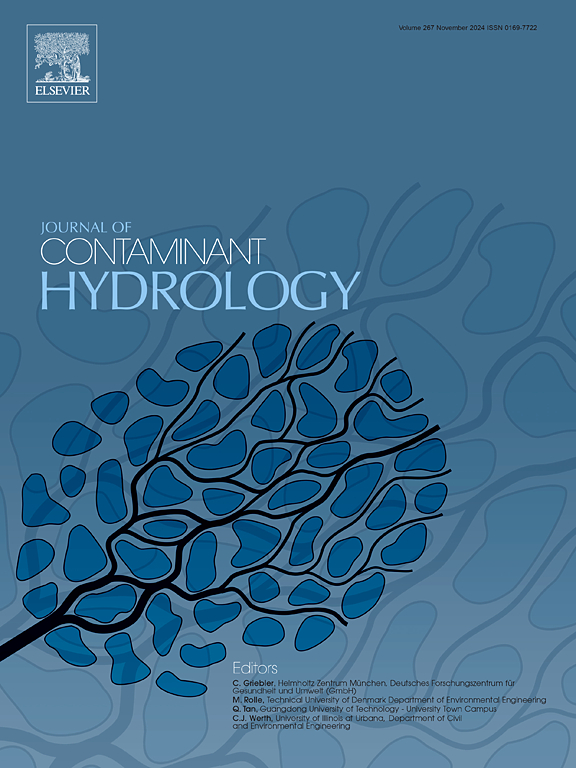Molecular insights into the Tl(I) binding capacity and response sequences of soil humic acids from different sources
IF 3.5
3区 环境科学与生态学
Q2 ENVIRONMENTAL SCIENCES
引用次数: 0
Abstract
Humic acid (HA) significantly affects the migration, transformation, and environmental fate of Tl(I) through complexation. However, knowledge of the interaction processes and interfacial mechanisms between HA and Tl(I) remains lacking. Here, we investigated the Tl(I) binding characteristics of Sigma-HA and soil HAs from representative watersheds in China at the molecular level using adsorption models, an excitation-emission matrix with parallel factor analysis (EEM-PARAFAC), and two-dimensional correlation spectroscopy (2D-COS). According to the isothermal adsorption modeling results, SSHA exhibited the greatest attraction for Tl(I). However, YSHA exhibited the lowest value. On the one hand, the content of oxygen-containing functional groups on HAs may influence the adsorption capacity for Tl(I). On the other hand, the EEM-PARAFAC analysis results revealed that the UV humic-like component (C3), which is unique to SSHA, plays a crucial role in determining Tl(I) binding as a more effective complexing species (log KM = 5.248). For the binding responsiveness of HAs, the 2D-COS results indicated that the carboxyl and phenolic hydroxyl groups associated with humic-like components in SSHA are the optimal structures for Tl(I) binding, whereas the polysaccharides and aliphatics in YSHA and PSHA are more sensitive. These findings increase our understanding of environmental behavior of Tl(I) and provide a solid theoretical foundation for evaluating the effectiveness of HA remediation in Tl-contaminated soils.

对不同来源土壤腐殖酸的 Tl(I)结合能力和响应序列的分子认识
腐殖酸(HA)通过络合作用对 Tl(I)的迁移、转化和环境归宿产生重大影响。然而,有关 HA 与 Tl(I) 之间的相互作用过程和界面机制的知识仍然缺乏。在此,我们采用吸附模型、激发-发射矩阵与并行因子分析(EEM-PARAFAC)以及二维相关光谱(2D-COS)等方法,从分子水平研究了中国代表性流域的Sigma-HA和土壤HAs与Tl(I)的结合特性。根据等温吸附模型的结果,SSHA 对 Tl(I)的吸引力最大。然而,YSHA 的吸附值最低。一方面,HAs 上含氧官能团的含量可能会影响对 Tl(I)的吸附能力。另一方面,EEM-PARAFAC 分析结果表明,SSHA 特有的紫外腐殖样成分(C3)作为更有效的络合物种(log KM = 5.248),在决定 Tl(I) 结合力方面起着至关重要的作用。关于HAs的结合反应性,二维-COS结果表明,SSHA中与类腐殖质成分相关的羧基和酚羟基是Tl(I)结合的最佳结构,而YSHA和PSHA中的多糖和脂肪族则更为敏感。这些发现加深了我们对 Tl(I) 环境行为的理解,并为评估 HA 在受 Tl 污染的土壤中的修复效果提供了坚实的理论基础。
本文章由计算机程序翻译,如有差异,请以英文原文为准。
求助全文
约1分钟内获得全文
求助全文
来源期刊

Journal of contaminant hydrology
环境科学-地球科学综合
CiteScore
6.80
自引率
2.80%
发文量
129
审稿时长
68 days
期刊介绍:
The Journal of Contaminant Hydrology is an international journal publishing scientific articles pertaining to the contamination of subsurface water resources. Emphasis is placed on investigations of the physical, chemical, and biological processes influencing the behavior and fate of organic and inorganic contaminants in the unsaturated (vadose) and saturated (groundwater) zones, as well as at groundwater-surface water interfaces. The ecological impacts of contaminants transported both from and to aquifers are of interest. Articles on contamination of surface water only, without a link to groundwater, are out of the scope. Broad latitude is allowed in identifying contaminants of interest, and include legacy and emerging pollutants, nutrients, nanoparticles, pathogenic microorganisms (e.g., bacteria, viruses, protozoa), microplastics, and various constituents associated with energy production (e.g., methane, carbon dioxide, hydrogen sulfide).
The journal''s scope embraces a wide range of topics including: experimental investigations of contaminant sorption, diffusion, transformation, volatilization and transport in the surface and subsurface; characterization of soil and aquifer properties only as they influence contaminant behavior; development and testing of mathematical models of contaminant behaviour; innovative techniques for restoration of contaminated sites; development of new tools or techniques for monitoring the extent of soil and groundwater contamination; transformation of contaminants in the hyporheic zone; effects of contaminants traversing the hyporheic zone on surface water and groundwater ecosystems; subsurface carbon sequestration and/or turnover; and migration of fluids associated with energy production into groundwater.
 求助内容:
求助内容: 应助结果提醒方式:
应助结果提醒方式:


